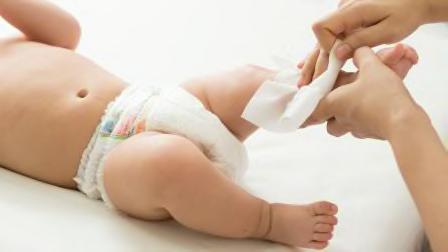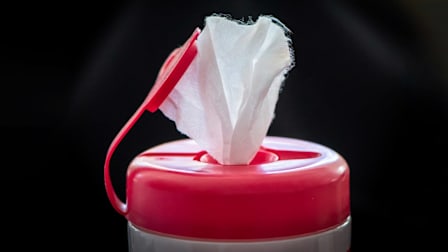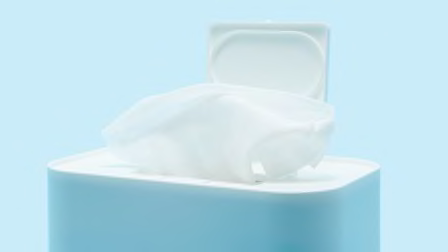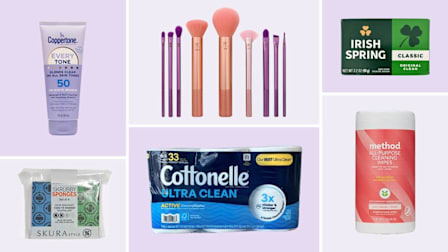We Tried It: Propre French Diaper Care
This baby wipe system is unlike anything we’ve ever used
When you shop through retailer links on our site, we may earn affiliate commissions. 100% of the fees we collect are used to support our nonprofit mission. Learn more.

For my first four sons, now ages 2 to 8, diapers and wipes were about the quickest, easiest options. I’d bulk-shop, not really worrying much about ingredients, trying to survive inflation in my world of multiple diaper changes a day on multiple kids.
But then I had my daughter, a more sensitive-skinned princess diva, as her brothers refer to her. At the same time, my family started to reconsider most of the products coming into our home. What chemicals were in baby shampoo? Why were we still heating up food in plastic containers? What’s really in that sports drink my son grabs as he heads out to practice in a rush? So logically, diapers and wipes were next on the list to consider when dealing with a more sensitive baby.
My concern is top of mind for other parents as well as they choose baby wipes without harmful chemicals. This especially matters when it’s much more than butts that I’m using them for as a busy working mom on the go. They double as tissues in the grocery store line in a pinch and as a washcloth for syrupy hands at breakfast. I’ve even been known to wipe down my car’s cup holders with a spare wipe. They are for everything. So it was time to make sure they didn’t contain chemicals that wouldn’t work for everything, from messy faces and noses to butts and feet.
By now, some might be thinking, What’s so wrong with traditional baby wipes? When Consumer Reports partnered with Made Safe earlier this year, we sought to answer that. Made Safe, an organization that works to ensure that consumer products are made with less harsh ingredients for consumers and the planet, is led by founder and executive director Amy Ziff. Baby wipe testing by Made Safe and Consumer Reports revealed results that Ziff says parents might find “equally shocking and empowering.” Here’s why:
- Some wipes are bad for the environment. “One of the biggest issues is what the substrate material is made from—nondegradable petroleum-derived plastic substrates. These are an environmental nightmare,” Ziff says. “Given that it is estimated that a single infant will require the use of thousands of baby wipes a year, this will result in millions of wipes landing in landfills or waterways every year. Those wipes not only contribute to pollution, but they leach chemicals and pollution as they sit, shedding microplastics into the environment.”
- Some wipes contain harsh chemicals or less-than-ideal pH levels. Top baby wipe brands, including Huggies and Pampers, were found to have known and probable risks. For example, Pampers Aqua Pure Wipes were found to have a low pH, which might increase the risk of skin irritation. Huggies Natural Care Sensitive & Fragrance-Free contains butoxy PEG-4 PG-amodimethicone and other ingredients with both known and probable risks to human health and the environment.
- Wipes can contain ingredients that can cause irritation or discomfort. Navin Arora, DO, founder of Borealis Dermatology on Long Island, N.Y., says that babies can be allergic to certain ingredients in wipes, which might lead to redness, itching, or swelling. “Skin irritation is a common concern, especially in babies with sensitive skin,” he says. “Some wipes contain fragrances, alcohol, or preservatives that can cause rashes and discomfort. It is important for parents to choose hypoallergenic and fragrance-free wipes to minimize the risk of irritation.”
With these red flags in mind, I pushed my traditional wipes, which suddenly seemed to be teeming with unseen dangers like my kid’s favorite sugary cereals, into a drawer. In their place, I set up the Propre French Diaper Care system, channeling my inner French mama, who I assume has it much more together than I do.
How Does Propre French Diaper Care Work?
In line with this mission, I recently evaluated the fanciest wipes of all—Propre French Diaper Care, which is so far from a dollar-store wipe that it’s unrecognizable. The French Diaper Care system consists of a cleansing liquid that feels like a cross between a thin lotion and soap, and small, square cotton pads. You simply squirt a few pumps of the liquid onto a pad, smoosh it around a bit (a very technical process), and wipe the baby’s booty. I was apprehensive about evaluating this product because it seemed like an extra step in an already cumbersome and annoying process, but I was pleasantly surprised.
Setup was exceptionally simple—just twist the pump to dispense the cream and arrange the cotton pads nearby. It would be helpful to have a container of some type to hold the cotton pads, but a simple basket ended up serving this purpose.
The diaper care system contains a few ingredients that are all natural and mostly pronounceable, including organic olive oil; organic sunflower seed oil; beeswax, limewater; and glyceryl stearate, a lubricant and fatty acid.
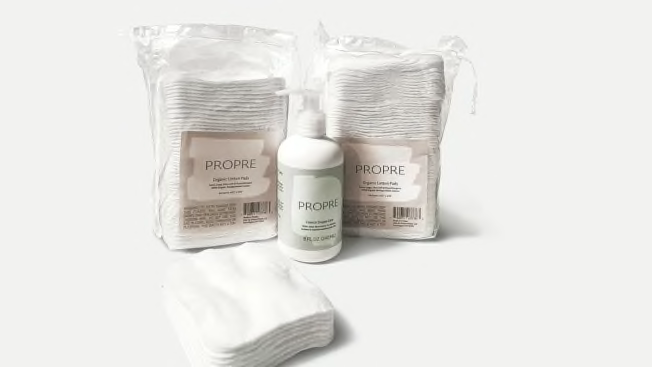
Photo: Alexandra Frost Photo: Alexandra Frost
How Propre Felt
If I could speak for my 5-month-old, I’d conclude she felt more comfortable with this system over what seems like scratchy wipes in comparison. The liquid felt like a cross between a light diaper cream, coconut oil, and a gentle soap. When you touch your own skin or the baby’s after using it, it feels like you’ve just had a manicure with an oil treatment finish, and the baby’s skin feels like you’ve applied cream. So it’s an all-in-one wipe and cream, eliminating a step.
I judged its efficacy by my baby’s reaction: There was a bit less fussing around messy diaper changes. This was most obvious during times when her bottom was already irritated from having recently pooped, or if she’d had a pee diaper on longer than I’d like before I caught it. During those times when her skin already seemed sensitive, this product may have felt like a relief rather than an additional stressor on her skin. This comes down to more natural ingredients and a softer application pad than a traditional wipe.
“Liniment typically consists of olive oil and limewater, making it a natural and gentle option for cleansing the skin. Parents who prefer natural and minimalistic approaches to baby care may find this method appealing,” Arora says. “Liniment can be moisturizing, helping to prevent dryness and irritation in the diaper area, especially for babies with sensitive skin.” He adds that parents concerned with chemicals can opt for this over “commercial” baby wipes.
How the Propre System Handled the Mess
One of the main concerns I had as a parent switching from a sturdy wipe to a small cotton pad with a lotion liquid was, Would it withstand all that babies have to throw their way? By that, of course, I mean nasty poop disasters. The difference, I found out from Cheryl Bayart, MD, MPH, a pediatric dermatologist at Cincinnati Children’s Hospital, isn’t in my head, but in the absence of “surfactants.” These are detergents or cleansers, she explained, and help with ease of cleaning. But the fewer ingredients, the better, she says, even if that means losing that convenient surfactant.
“Surfactant provides convenience by facilitating cleaning, but adequate cleansing with less risk of skin irritation can be achieved with plain water or mineral oil. Surfactants such as cocamidopropyl betaine and preservatives are common allergens,” she says. She points to how, even a decade ago in 2013, the American Contact Dermatitis Society named methylisothiazolinone (MI) “allergen of the year.” “At the time, MI and its cousin methylchloroisothiazolinone [MCI] were very widely used as preservatives in wipes. Many wipes continue to contain them.”
Given this information, I was unsure if it could hold up to more than just watery baby poop. Turns out, it does pretty well. Changing my 5-month-old was a breeze, as she is breastfed and doesn’t produce hard stools. My 2-year-old, on the other hand, required a few more cotton pads and a bit more patience as he wrangled around the diaper table, balking at my extra—and what probably seemed to be unnecessary—minutes of cleaning. But he is typically quite sensitive and seemed to benefit from the lotion solution by having less irritation throughout the week.
There can be a particular complication, I found out, from trying too hard to make this diaper care system work on really tough poop messes, particularly if the poop is stuck on the skin or isn’t very watery (gross—sorry—parenting …).
Amy Wechsler, MD, FAAD, a dermatologist and psychiatrist in New York, speaks to this issue just as I experienced it with my 2-year-old: “Some liniments are irritating—I think it’s easier to clean with something that is wet. Also, with liniments, sometimes one has to rub too hard, and that can irritate the skin.” Sadly, a toddler that woke up on the wrong side of the bed with poop fit that description perfectly, and the scrubbing itself became a bit much for his skin. Though he didn’t show any redness or rash, his skin seemed irritated at the end of the cleaning attempt.
How Long Should You Expect Propre to Last?
While I already knew how long a pack of wipes would last when I bought it, I wasn’t too sure how long to expect with this product. The company claims that the lotion lasts about a month. This tracks with my usage so far, though I wonder if I’ll finish the packs of pads before the lotion runs out. The company also estimates one pad for wet diapers and one to three for soiled diapers, and that babies up to 6 months old need one to two bottles of lotion, while babies 6 months to 12 months need just one. For those older than that, it anticipates half a bottle or less. I didn’t find it to be too expensive or overly stressful budget-wise, given how slowly overall I went through the product.
A company representative told me in an email that it is working on a travel-sized version of the lotion to make diaper changes on the go much easier. But for now, the bottle does lock for transport in a diaper bag—a must-have feature. When the company does release the travel-sized product, this will help to make the original product last a bit longer, which I will then leave on the diaper table at home.
Is Propre Worth It?
Overall, the shiny and soft feeling my baby has on her body when I’m done using this product made it worth switching up my processes after years of changing diapers. It seems like a genuinely better product than the traditional wipes, and I will keep using it going forward. I’d recommend this, especially for babies who have rashlike problems.
I also anticipate, along with Ziff, that future babies will have the luxury of improved products with fewer chemicals overall. “The baby market is an area where consumers care enormously about what they are using, and companies should do more to address the marketplace demand,” she says.
And for that, my baby’s skin and health, and my mama mind, are appreciative.

















